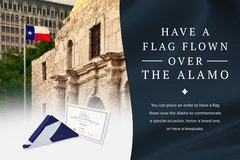Dr. R. Bruce Winders, Former Alamo Director of History and Curator
From 1718 until 1835, the Spanish and then Mexican military used San Antonio as a half-way stop from the settlements along the Rio Grande to those in east Texas. San Antonio’s central location provided not only a place to rest and resupply, but had strategic value, as soldiers stationed there could be deployed in a variety of directions depending on where they were needed. Once Texan rebels captured the city in December 1835, however, San Antonio’s military role shifted to defense. Following the revolution, San Antonio remained a defensive outpost throughout the nine years of the Republic of Texas. With the annexation of Texas to the United States in 1845, however, San Antonio’s military role evolved again as the city became a central hub of military traffic and supply.
Upon annexation, President John Tyler granted the former republic all of the rights guaranteed other states, including the right of protection from foreign powers. Uncertainty over how Mexico would react to annexation — especially with Texas’ claim of the Rio Grande as its border — required U.S. troops on the ground as soon as possible. By late July 1845, the U.S. Army began concentrating soldiers at Corpus Christi near the mouth of the Nueces River. In March 1846, the army, led by General Zachary Taylor, marched to the Rio Grande. Mexico viewed this movement as a hostile act and in late April attacked a detachment of U.S. Dragoons. President James K. Polk proclaimed “American blood has been shed on American soil” and Congress declared war on Mexico on May 13, 1846.
United States army officers visited San Antonio in early 1846 in advance of Taylor’s move to Texas. A clause in the annexation treaty called for all existing forts and military installations in Texas to be turned over to the U.S. Army for its use. This included the Alamo, which was in disrepair and missing walls following the famous battle a decade earlier. Officers of the U.S. Army Quartermaster department decided to repair and use the old mission’s remaining structures, and by 1847, the old convent had been turned into a two story warehouse. In 1850, still needing more room, the army’s Quartermaster General ordered the roofless church repaired and a second floor created in the building. When informed by the Catholic Archdiocese that the old mission property still belonged to them — a fact confirmed by the Republic of Texas in 1841 — the army began paying rent to use the Alamo as a regional quartermaster depot.




